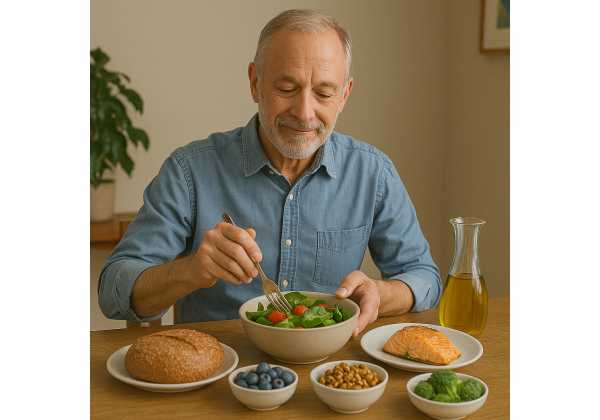
Healthy brains age with purpose. They remember names, follow conversations in busy rooms, and learn new skills late in life. Food cannot rewrite genetics, but daily patterns do shape risk pathways that matter: vascular health, inflammation, insulin resistance, oxidative stress, and the gut brain axis. Two evidence-led styles of eating—the Mediterranean diet and its neurology-focused cousin, the MIND pattern—translate this science into grocery choices and meals you can repeat. In this guide, you will learn what to put on your plate (and why), how to time and combine foods for better energy and focus, and how to build a weekly rhythm you can sustain. For a broader framework on tying brain nutrition into whole-body aging—protein distribution, plant variety, and polyphenols—see our concise overview of longevity-focused nutrition patterns.
Table of Contents
- Core Foods of Mediterranean and MIND Patterns
- Omega 3s and Choline for Brain Structure and Function
- Polyphenols That Support Cognition: Berries and Olive Oil
- Blood Sugar Stability and Brain Health
- Fermented Foods and the Gut Brain Axis
- Sample Week of Brain Healthy Meals
- Foods to Limit for Cognitive Longevity
Core Foods of Mediterranean and MIND Patterns
The Mediterranean diet is a regional template built around plants, olive oil, legumes, whole grains, fish, and modest dairy, with wine optional and typically taken with meals. The MIND pattern—short for Mediterranean-DASH Intervention for Neurodegenerative Delay—keeps that backbone and doubles down on brain-forward specifics: dark leafy greens most days, other vegetables daily, berries several times per week, nuts as a default snack, beans weekly, poultry and fish preferred over red meat, and olive oil as the primary fat. Pastries, processed snacks, fried foods, high-sodium fast food, and butter-heavy cooking appear less often.
Why these foods? Because they work via converging mechanisms:
- Vascular protection. The brain is an energy-intensive organ that depends on resilient blood vessels. Olive oil polyphenols, omega-3–rich fish, legumes, and leafy greens support endothelial function and nitric oxide signaling while favorably shifting lipids and inflammation. Better arteries mean better perfusion and fewer “silent” ischemic hits that chip away at attention and processing speed.
- Antioxidant and anti-inflammatory tone. Vegetables, berries, herbs, and extra-virgin olive oil (EVOO) supply polyphenols that upregulate endogenous defenses (e.g., Nrf2 pathways) and modulate microglial reactivity. The goal isn’t zero inflammation; it’s a balanced, responsive immune state.
- Insulin sensitivity. Whole grains, beans, nuts, and fiber from produce slow glucose entry, reducing glycemic variability that can impair cognition over time. Stable glucose supports steady energy and mood.
- Synapse and membrane integrity. Seafood, eggs, and legumes deliver building blocks for neuronal membranes (omega-3 fatty acids, choline, phospholipids), while minerals like magnesium and potassium support neuronal excitability and vascular tone.
- Microbiome crosstalk. Fermented foods and diverse fibers produce short-chain fatty acids (SCFAs) and other metabolites that influence blood–brain barrier permeability, neurotransmitter precursor availability, and systemic inflammation.
A practical week captures these themes without feeling restrictive:
- Base every meal on plants. Fill half the plate with vegetables (leafy + colorful) or fruit at breakfast; add beans or lentils most days.
- Choose EVOO as default fat. Use it for salad dressings, low-to-moderate heat cooking, and as a finishing drizzle on vegetables and grains.
- Fish 2–3 times per week. Favor SMASH species (sardines, mackerel, anchovies, salmon, herring) for omega-3 density.
- Nuts as a habit. A small handful (20–30 g) most days.
- Whole grains on rotation. Oats, barley, farro, buckwheat, brown rice, and sourdough bread.
- Flavor with herbs, spices, citrus, garlic, and vinegar rather than heavy sauces.
Meal design rule: “Protein + produce + EVOO” at each sitting. Add legumes or whole grains for staying power, and berries at least twice weekly for a targeted polyphenol nudge. Keep red meat small and infrequent; keep ultra-processed snacks occasional.
Omega 3s and Choline for Brain Structure and Function
Neuronal membranes are lipid-rich. The omega-3 fatty acids DHA (docosahexaenoic acid) and EPA (eicosapentaenoic acid) integrate into phospholipid bilayers, influencing membrane fluidity, receptor function, and synaptic signaling. DHA is especially concentrated in synapses and photoreceptors. EPA serves as a precursor to specialized pro-resolving mediators that help turn off inflammation after it has done its job. Choline, meanwhile, is required for acetylcholine synthesis (attention, memory) and for phosphatidylcholine, a major membrane phospholipid that transports DHA into the brain.
Food strategy first.
- Fish and seafood two to three times weekly is the most efficient path to DHA/EPA. A typical 100–120 g serving of salmon delivers ~1.5–2.0 g EPA+DHA; sardines and mackerel are similarly rich.
- Eggs (especially omega-3–enriched) contribute both DHA (modest amounts) and choline (~125–150 mg per large egg).
- Plant sources (flax, chia, walnuts, hemp) supply ALA (alpha-linolenic acid). Humans convert ALA to DHA/EPA poorly (often <10% to EPA and <5% to DHA), but these foods still support cardiometabolic health and total omega-3 balance.
- Algae-based DHA offers a fish-free option and is the direct structural form the brain uses.
How much is enough? For dietary patterns, aim for 2–3 fish meals per week and daily choline exposures (eggs, soy, legumes, lean poultry). People who avoid fish can use algal DHA (200–400 mg/day) to cover structural needs. Those with high triglycerides, insulin resistance, or nonalcoholic fatty liver disease should discuss higher EPA+DHA intakes with a clinician, as dosing shifts with therapeutic goals.
Choline targets and sources. Many adults fall short of the Adequate Intake (women 425 mg/day, men 550 mg/day). Practical ways to meet needs:
- 2 eggs (~250–300 mg) + 1 cup soybeans/edamame (~100 mg) + 1–2 servings poultry or fish (50–100 mg each) spread across the day.
- For plant-forward eaters, emphasize soy foods, beans, quinoa, and crucifers; consider eggs if you include them.
Putting it together on a plate:
- Sardine-tomato toast with capers and arugula (DHA/EPA + polyphenols)
- Omelet with spinach and mushrooms, olive-oil dressed salad, and berries
- Tofu-vegetable stir-fry with sesame–garlic sauce; side of seaweed and edamame
- Oats with walnuts and ground flax; add an algal DHA capsule if fish-free
For a deeper dive into choosing seafood and algae sources, see our concise guide to omega-3 food strategies.
Polyphenols That Support Cognition: Berries and Olive Oil
Polyphenols are a large family of plant compounds—flavonoids, phenolic acids, stilbenes, lignans—shaping color, aroma, and defense in plants and resilience in humans. In the brain, they act less like direct antioxidants and more like signalers: nudging gene expression, supporting nitric oxide bioavailability, and modulating neuroinflammation. Two everyday vehicles stand out for cognitive aging: berries and extra-virgin olive oil (EVOO).
Berries as a vascular-neuro link. Blueberries, blackberries, strawberries, and raspberries deliver anthocyanins and other flavonoids that reach the brain in small amounts yet shift vascular function measurably. In older adults, regular berry intake has repeatedly improved processing speed, executive function, or word recall in trials that last weeks to months. Mechanisms include enhanced endothelial nitric oxide, improved cerebral perfusion, and support of hippocampal signaling. Practical takeaway: 2–3 berry servings per week is a reasonable minimum; daily is fine. Fresh, frozen, or lightly cooked all count; choose unsweetened when possible.
Olive oil as a polyphenol carrier. High-polyphenol EVOO (fruity, pungent, slightly bitter) brings hydroxytyrosol, oleocanthal, and other phenolics that protect LDL from oxidation, reduce vascular inflammation, and may influence amyloid and tau pathways in mechanistic models. In practice, replacing butter and refined seed oils with EVOO improves overall diet quality and the balance of fats used to build cell membranes.
How to amplify effects without complexity:
- Dress greens and roasted vegetables with 2–3 teaspoons EVOO and an acid (lemon, red wine vinegar).
- Add ½–1 cup berries to breakfast or a midafternoon yogurt.
- Combine berries with nuts (walnuts, almonds) and dark chocolate for polyphenol synergy and sustained energy.
- Cook with EVOO at low-to-moderate heat and finish dishes with a fresh drizzle for flavor and phenolics.
Shopping cues: Choose EVOO in dark bottles, within a year of harvest, with a best-by date in the future. Taste matters—bitterness and peppery “throat catch” signal active phenolics. If you want to go deeper on selection and kitchen use, see our quick primer on choosing and using high-polyphenol olive oil.
Alternatively, for broader polyphenol coverage—not just berries and olive oil—scan our short list of everyday sources and how to use them in polyphenol-rich foods.
Blood Sugar Stability and Brain Health
The brain runs largely on glucose, but how quickly that glucose arrives affects how you feel and perform. Rapid spikes followed by steep drops can leave you foggy, irritable, and hungry. Over years, wide glycemic variability and insulin resistance damage blood vessels and accelerate pathways that undermine cognition. A brain-healthy diet keeps glucose steady, not low at all costs.
Principles that flatten the curve:
- Protein and fat first. Start meals with protein (fish, eggs, yogurt, tofu) and EVOO-dressed vegetables. This slows gastric emptying and reduces peak glucose compared to eating starches alone.
- Fiber as a brake. Legumes, intact whole grains, nuts, and seeds reduce the speed of digestion and provide viscosity that delays absorption.
- Smart carbs. Choose intact grains (oats, barley, farro), beans and lentils, and root vegetables over refined flours and quick cereal products.
- Timing around activity. Put your largest carbohydrate load near movement—before a walk or after resistance training—to improve glucose disposal.
- Evening strategy. A protein-plus-produce dinner with modest starch supports stable overnight glucose and better sleep.
- Beverage discipline. Sugary drinks cause the fastest spikes; choose water, tea, coffee, or sparkling water with citrus.
Meal pattern examples:
- Breakfast: Greek yogurt + berries + walnuts; side of oats or seeded toast if still hungry.
- Lunch: Lentil-grain bowl (lentils, farro, roasted vegetables) with tahini–lemon drizzle.
- Dinner: Salmon, roasted carrots and broccoli, small portion of potatoes with EVOO and herbs.
- Snacks: Edamame, a small handful of nuts, kefir, or an apple with peanut butter.
If you’re exploring the relationship between meal construction and continuous glucose patterns, our practical guide on flattening glucose swings with food lays out simple sequencing and swap ideas. For a more technical angle on carbohydrate quality and mixed meals, skim our overview of glycemic load in healthy aging.
Fermented Foods and the Gut Brain Axis
Your gut and brain communicate constantly via neural, hormonal, and immune signals. Diet shapes that conversation. Fermented foods—yogurt, kefir, kimchi, sauerkraut, miso, tempeh, natto, kombucha—introduce live microbes and bioactive metabolites; prebiotic fibers (from beans, oats, Jerusalem artichokes, onions, garlic, bananas) feed resident microbes. Together they increase production of short-chain fatty acids such as butyrate, which tighten intestinal barriers, influence microglia, and support anti-inflammatory tone.
What this means for day-to-day cognition: people often notice steadier energy and less bloating as the gut calms down, and some trials show improvements in stress reactivity and measures of attention or memory with regular fermented food intake. While strains and doses vary widely, the pattern is clear: more microbial diversity from varied plants and ferments tends to track with better metabolic and inflammatory profiles.
Make it practical:
- Aim for 1–2 fermented servings daily. Examples: ¾–1 cup kefir or yogurt, 2–3 tbsp kimchi or sauerkraut with meals, 1 cup miso soup, a palm-size portion of tempeh.
- Pair ferments with fiber in the same bowl: yogurt with oats and berries; kimchi alongside lentil-rice bowls; tempeh with buckwheat noodles and greens.
- Choose plain fermented dairy and flavor it yourself to avoid added sugars.
- If you’re new to ferments, titrate slowly to comfort and vary the types week to week.
For a streamlined tour of options and serving ideas, jump to our short guide on fermented foods in healthy aging. If your gut is sensitive, start with low-FODMAP ferments (e.g., certain yogurts, hard cheeses) and build tolerance over time with support from a clinician or dietitian.
Sample Week of Brain Healthy Meals
Use this sample week to translate principles into plates. Portions can be adjusted to your energy needs; the structure stays the same: produce + protein + EVOO, with legumes and whole grains rotating in, berries several times, and fish or soy on repeat.
Day 1
- Breakfast: Plain Greek yogurt, blueberries, walnuts, cinnamon; drizzle of EVOO.
- Lunch: Chickpea–farro tabbouleh with parsley, tomatoes, cucumber, lemon, and EVOO; side of olives.
- Snack: Kefir with grated ginger.
- Dinner: Salmon with roasted broccoli and carrots; small portion of potatoes tossed in EVOO and herbs.
Day 2
- Breakfast: Vegetable omelet (spinach, mushrooms, peppers), side of berries.
- Lunch: Lentil soup with barley and kale; side salad with EVOO–balsamic.
- Snack: Apple with almond butter.
- Dinner: Tempeh stir-fry with bok choy, snap peas, and sesame; brown rice.
Day 3
- Breakfast: Oats cooked with chia and flax; a few crushed walnuts; sliced strawberries.
- Lunch: Sardine–tomato toast on whole-grain sourdough with capers and arugula.
- Snack: A small handful of mixed nuts.
- Dinner: Chicken thigh braised with olives, tomatoes, and eggplant; polenta; side salad.
Day 4
- Breakfast: Cottage cheese (or soy skyr) with pear and pumpkin seeds; sprinkle of cocoa nibs.
- Lunch: Black bean bowl with quinoa, roasted sweet potatoes, red cabbage slaw, and avocado; lime–cilantro dressing.
- Snack: Kombucha (unsweetened or low-sugar) with a few almonds.
- Dinner: Mussels in tomato–garlic broth; crusty whole-grain bread; fennel–orange salad.
Day 5
- Breakfast: Kefir smoothie with spinach, frozen berries, oats, and a spoon of tahini.
- Lunch: Mediterranean chopped salad with cannellini beans, artichokes, cucumbers, peppers, EVOO, and lemon.
- Snack: Dark chocolate (70–85%) with a few hazelnuts.
- Dinner: Tofu “piccata” with lemon and capers; sautéed chard; farro.
Day 6
- Breakfast: Sourdough with mashed avocado, cherry tomatoes, and a soft-boiled egg.
- Lunch: Miso-ginger salmon sashimi bowl with brown rice, edamame, seaweed, and cucumbers.
- Snack: Yogurt with a spoon of ground flax.
- Dinner: Bean and vegetable minestrone; side of roasted Brussels sprouts with EVOO and lemon zest.
Day 7
- Breakfast: Buckwheat pancakes (minimal sweetener) topped with sautéed berries and a dollop of yogurt.
- Lunch: Hummus plate with olives, cucumbers, carrots, and whole-grain pita; side salad of arugula and herbs.
- Snack: Orange and a few pistachios.
- Dinner: Grilled mackerel with tomato–olive relish; barley with parsley; steamed greens.
Batch-prep and rhythm tips:
- Cook a pot of beans (or open low-sodium cans), two whole grains, and a tray of roasted vegetables on the weekend.
- Keep frozen berries and edamame on hand; they thaw quickly and reduce waste.
- Stock two EVOOs: one everyday bottle, one peppery, high-polyphenol oil for finishing.
- Pre-portion nuts into 20–30 g servings to simplify snacking.
If you want a printable checklist and freezer-friendly batch plan that maps onto this week, see our kitchen workflow for meal prep for longevity.
Foods to Limit for Cognitive Longevity
Longevity eating isn’t only about additions; strategic limits reduce vascular strain, metabolic swings, and background inflammation.
Refined grains and sugary foods.
- White breads, pastries, sweetened cereals, and desserts cause rapid glucose spikes and drive energy crashes. Keep them occasional and pair with protein and fiber when included. Choose fruit or dark chocolate as default sweets.
Ultra-processed snacks and fast foods.
- Chips, crackers, and fried items concentrate refined starches, seed oils, sodium, and additives that displace nutrient-dense foods. Frequency matters more than perfection—cutting these from daily to once or twice per week frees room for nuts, fruit, and legumes.
Processed meats and high-sodium items.
- Sausages, bacon, deli meats, and many packaged soups strain vascular health and can raise blood pressure. Choose poultry, fish, legumes, or small portions of unprocessed meats instead.
Excess alcohol.
- Heavy intake harms sleep, increases inflammation, and raises dementia and stroke risk. If you drink, keep it modest, with several alcohol-free days per week, and always with food. If cutting back is a goal, replace the ritual: sparkling water with citrus or a splash of tart cherry juice.
Butter and high-saturated-fat spreads.
- Replace with EVOO for everyday cooking and finishing. Keep butter as an occasional flavor accent rather than a base fat.
High-sugar beverages.
- Soda, sweet teas, energy drinks, and many bottled coffees are the fastest route to glucose volatility. Choose water, tea, black coffee, or unsweetened alternatives.
Caffeine timing, not elimination.
- Moderate amounts can sharpen attention, but late-day caffeine reduces sleep depth. Shift intake to the morning and early afternoon; pair coffee or tea with a calorie-containing breakfast or snack to avoid jitters.
Sodium awareness without obsession.
- Most sodium hides in breads, sauces, soups, and restaurant meals. Favor home cooking, herbs, citrus, and vinegars; choose low-sodium staples when possible.
Finally, upgrade by replacement, not just removal. Swap a pastry for Greek yogurt and berries; trade fries for olive-oil roasted potatoes and greens; make nuts your default snack. Over months, these small decisions accumulate into measurable vascular and cognitive dividends.
References
- Trial of the MIND Diet for Prevention of Cognitive Decline in Older Persons (2023) (RCT)
- Mediterranean diet improves cognition: the PREDIMED-NAVARRA randomised trial (2013) (RCT)
- Wild blueberry (poly)phenols can improve vascular function and cognitive performance in healthy older individuals: a double-blind randomized controlled trial (2023) (RCT)
- Omega-3 fatty acids and cognitive function (2023) (Review)
- Fermented Foods, Health and the Gut Microbiome (2022) (Review)
Disclaimer
This article provides general information for educational purposes and is not a substitute for personalized medical advice, diagnosis, or treatment. Nutrition needs vary with health status, medications, and personal goals. Consult a qualified clinician or registered dietitian before making significant dietary changes or starting supplements, especially if you have cardiovascular disease, diabetes, cognitive impairment, gastrointestinal disorders, or take prescription medications.
If this guide helped you, please consider sharing it on Facebook, X (formerly Twitter), or your favorite platform, and follow us for future updates. Your support helps us continue creating practical, trustworthy resources for healthy longevity.










